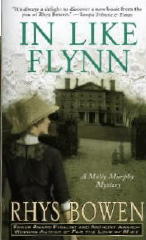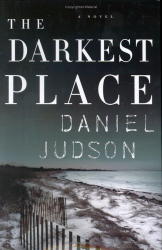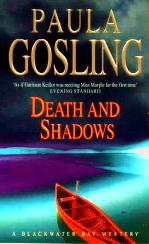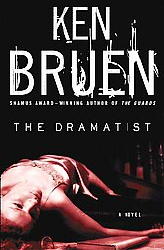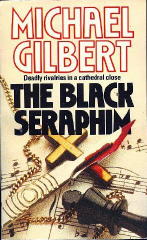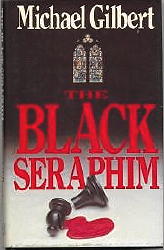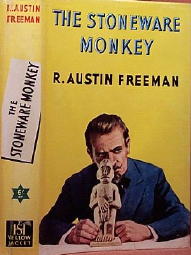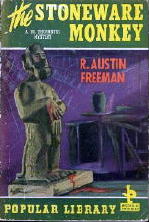Tue 17 Jul 2007
Review: ERLE STANLEY GARDNER – The Case of the Terrified Typist.
Posted by Steve under Authors , Characters , ReviewsNo Comments
ERLE STANLEY GARDNER – The Case of the Terrified Typist
Pocket 6108, paperback reprint; 1st printing, November 1961. Hardcover edition: William Morrow, January 1956. Detective Book Club [3-in-1 edition], February 1956. Other paperback editions: Pocket Cardinal C-275, August 1958. Pocket, 1967, October 1975. Ballantine, March 1987, July 1999. Other editions are likely.
There are certain authors who are so well known that there is very little chance that a review of one of their books is going to convince a would-be reader to read that author or not, even if that would-be reader has never even read that author. Sometimes one’s mind is made up, and there’s nothing that I could say that could change their opinion, either one way or the other.
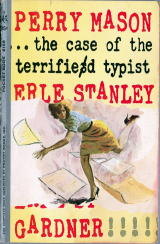
Case in point: Erle Stanley Gardner, and in particular the Perry Mason stories that he is known around the world for writing. In an unusal split in personality, fiction-wise, a number of people say that they like Gardner in his guise as A. A. Fair, but not when he’s writing under his own name, but stylistically, they read the same to me.
I recognize, of course, the various reasons why someone might not care for Gardner’s books. Maybe you (well, not necessarily you) don’t like courtroom dramas, especially those that you know pretty much when the courtroom scenes are going to take place, soon after about halfway through, with a break in the action while the courtroom’s in recess while Perry calls on his stalwart private eye Paul Drake to dig up the necessary evidence he suddenly realizes that he needs.
Those readers who like their detective figures to have personal lives have little to look forward to in the Perry Mason books. What do Perry and his faithful secretary do after their frequent dinners out together? It was never said, and it never will be. Gardner’s narratives and the dialogue from the mouths of his characters are of one piece, wooden, for the most part, and I suspect, repetitive in cadence and phrasing from book to book.
I recognize all of the above, and groan sometimes when an especially awkward bit of repartee between Perry, Paul and Della takes place, and sometimes — believe it or not — the clueing is not entirely is as seamless and tidied up as completely at the end as it should be. But once started one of the Perry Mason books, I simply cannot stop.
They usually begin with some strange, unusual occurrence that somehow happens to Perry or catches his eye in the newspaper or from his incoming mail, and The Case of the Terrified Typist is certainly no exception. Needing an ultra-efficient typist for some reason, Perry’s office is expecting one from an employment agency. When she arrives, she is very nervous, but she also proves to be one of the best typists they’ve ever had — until she disappears.
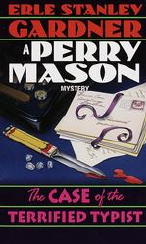
Until another office — a jewel importing firm — in the same building is found to have been vandalized. Until a wad of gum under the typist’s table is found to be concealing two diamonds. Until Perry is hired by the firm’s head office to represent one of the two men in charge of the local branch — he’s accused of killing the smuggler who brought the gems into the country but whose body has never been found.
Twist after new revelation after twist occurs, and trying to keep track of all of the participants and who’s telling the truth and who’s not will simply make one’s head swim. I know. It did mine. This is also one of the few cases in which Perry’s client is found guilty, until of course, the final twist and the final revelation that I guarantee you no one — no one, I tell you — no one will see coming, unless they just happen to have had their eyes fixed on the shell that contains the pea all along.
That is to say, one of the participants is telling the truth and the whole truth, and maybe if you identify which one of them it is, you will have a chance of pulling this one out. As for me, I never came close.
[PostScript] It was a coincidence only, but I’d just finished writing this review and was in the process of editing it when I saw on Bill Crider’s blog that today’s the 118th anniversary of Erle Stanley Gardner’s date of birth. He was born on this day in 1889.
So the review was rushed into (electronic) print, with some of the rough edges still showing, since smoothed away, I hope. For a fine overview of Gardner’s career as well as that of Perry Mason, you could do no better than visit The Rap Sheet, where Jeff Pierce discusses in great detail Ken Corning, Mason’s early counterpart in Black Mask magazine; the 1930s movies Mason was in; and above all, the superb choice made in casting Raymond Burr as Perry Mason, and in doing so, transforming the character into one of the immortals in the history of detective fiction.
